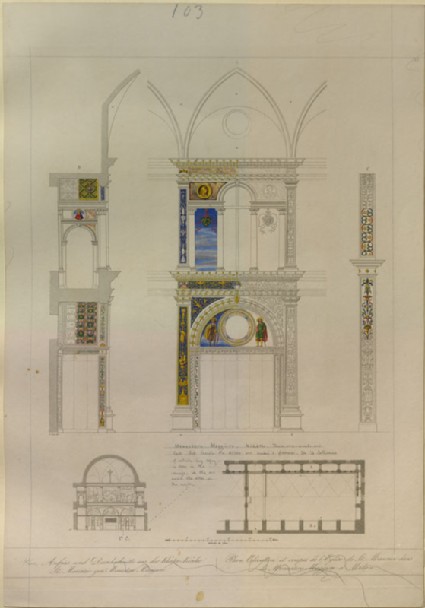Browse: 1470 objects
- Reference URL
Actions
Engraving of the Plan and Elevation of the westernmost Bay on the south Wall of the Lay Hall of San Maurizio al Monastero Maggiore, Milan Friedrich Lose
-
Details
- Artist/maker
-
Friedrich Lose (active 18th - 19th century) (designer)after Bernardino Luini (1480/85 - 1532)
- Object type
- Material and technique
- watercolour and bodycolour over engraving on wove paper
- Dimensions
- 493 x 344 mm (sheet, plate-mark unidentifiable)
- Associated people
-
Wilhelm Heinrich Ludwig Gruner (1801 - 1882) (publisher)
- Associated place
- Inscription
- Recto:
engraved:
at the bottom left of the main image: F. Lose del.
below the scale: Echelle du Plan
just to the right of the scale: Mètre
throughout the images, various letters identifying parts of the church
bottom, in two columns: Plan, Aufriss und Durchschnitte aus der Kloster-Kirche | St.. Maurizio gent. Monastero Maggiore || Plan, Elévation et coupes de l'Eglise de St.. Maurice dans le Monastero Maggiore à Milan
in graphite:
just below the main image, centre: Monastero Maggiore. MILAN. These ornaments are | late, but beside the altar are Luini's frescoes. The St Catherine | of which my copy | is here in the | centre ['centre' erased] | recess, is the one | next the altar on | the right.
just below the lower left image: St C. [a dotted line links these two inscriptions]
top, left of centre: 103
Verso:
bottom, left of centre, the Ruskin School's stamp
just to the right, in graphite: R103
- Provenance
-
Presented by John Ruskin to the Ruskin Drawing School (University of Oxford), 1875; transferred from the Ruskin Drawing School to the Ashmolean Museum, c.1949.
- No. of items
- 1
- Accession no.
- WA.RS.RUD.103
-
Subject terms allocated by curators:
Subjects
-
References in which this object is cited include:
References
Ruskin, John, The Ruskin Art Collection at Oxford: Catalogue of the Rudimentary Series, in the Arrangement of 1873, ed. Robert Hewison (London: Lion and Unicorn Press, 1984), cat. Rudimentary no. 103, RUD.103
Ruskin, John, Instructions in Practice of Elementary Drawing, Arranged with Reference to the First Series of Examples in the Drawings Schools of the University of Oxford (n.p., [1872]), cat. Rudimentary no. 103
Ruskin, John, Instructions in the Preliminary Exercises Arranged for the Lower Drawing-School (London: Smith, Elder, 1872), cat. Rudimentary no. 103
Ruskin, John, Instructions in the Preliminary Exercise Arranged For the Lower Drawing-School (London: Spottiswoode, 1873), cat. Rudimentary no. 103
Ruskin, John, ‘Rudimentary Series 1878’, 1878, Oxford, Oxford University Archives, cat. Rudimentary no. 103
Ruskin, John, ‘The Ruskin Art Collection at Oxford: Catalogues, Notes and Instructions’, Edward T. Cook and Alexander Wedderburn, eds, The Works of John Ruskin: Library Edition, 39 (London: George Allen, 1903-1912), 21, cat. Rudimentary no. 103
Location
-
- Western Art Print Room
Position in Ruskin’s Collection
Ruskin's Catalogues
-
Ruskin's Rudimentary series, 3rd ed. (1872)
R|103} Decoration of the Monastero Maggiore, Milan, Gruner’s plate. See my pencil note on it. E. -
Ruskin's Rudimentary series 4th ed. (1872)
R|103} Decoration of the Monastero Maggiore, Milan, Gruner’s plate. See my pencil note on it. E. -
Ruskin's Rudimentary series, 5th ed. (1873)
R|103} Decoration of the Monastero Maggiore, Milan, Gruner’s plate. See my pencil note on it. E. -
Ruskin's revision to the Rudimentary series (1878)
remains 103.One of Gruner’s engravings very admirably representing, as far as stamped colour and engraving can, one of the compartments of the church at Milan containing Luini’s frescoes , of which the St. Catherine in the alcove was chosen as a leading example. The decorations in the rest of the church are all of the finest time and perfectly represent to the student what painters like Luini, Carpaccio, and Perugino thought beautiful in building, condescending also themselves, like their great ancestors Cimabue and Giotto, frequently to execute the most subordinate details with their own hands. There is no saying what such architecture might have become had Italy persevered in the Christian faith. Its actual beauty was greatly interfered with by the impossibility of finding pupils good enough to work with the great masters, and such pupils could only have been supplied by a permanently disciplined & monastic school. Actually uneducated and infidel workmen were more and more admitted in the completion of the subordinate parts and the redundance of ornament became instantly vulgar when produced by sensual mechanism instead of religious R. enthusiasm. The main point which students have now to observe is that they need not pretend to imitate the Italian Renaissance until the best painters in the Academy are content to work on house-walls.





